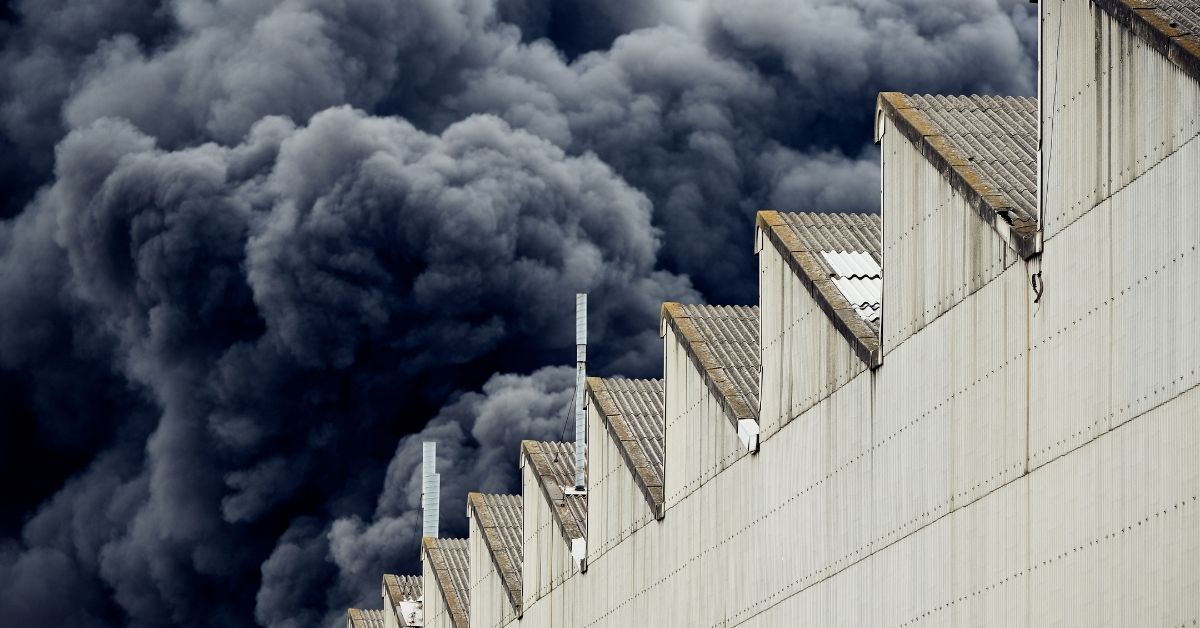Autumn can be one of the most challenging seasons for people who are sensitive to mold. As the weather cools and the landscape changes, the combination of damp leaves, fluctuating humidity, and decaying vegetation creates ideal conditions for mold growth and spore release. When leaves fall and begin to decompose, they become nutrient-rich breeding grounds for mold colonies. Every rake of a leaf pile or gust of wind can send millions of microscopic spores into the air.
Mold spores are especially common after the ragweed season ends and the first frost approaches: In other words, just as pollen counts start to drop, mold spore levels are often on the rise.1
Because mold spores are so small and easily inhaled, sensitive individuals often notice an uptick in allergy or asthma symptoms just when they think the worst of allergy season is over. Sneezing, coughing, nasal congestion, itchy eyes, and wheezing can all return or intensify—even without visible mold present. For someone who is mold-sensitive, autumn isn’t just about lingering pollen; it’s a prime time for outdoor mold exposure, indoor dampness, and higher airborne spore levels.
Given this seasonal surge, it’s worth taking a closer look at the two mold genera most commonly linked to autumn allergies in the U.S. and other temperate regions—Cladosporium and Alternaria. Understanding how they grow, how they affect health, and how to minimize exposure can make the difference between a comfortable fall and a sneezy, congested one.

Cladosporium
Cladosporium is not a single species but a genus of or subfamily molds—more than 500-species and the genus is ubiquitous both outdoors and indoors.2
Outdoors, Cladosporium lives on decaying plant matter, soil, compost, leaves, tree trunks, and similar substrates. Indoors it can colonize moist surfaces: under sinks, around faucets, carpets, upholstery, heating/cooling ducts, basements, bathrooms, attics.3
Cladosporium appears in clusters of black, yellow or green spots; but it’s important to note that accurate visual identification of species is usually impossible without laboratory testing. On building materials or indoor surfaces it may appear as dark-green, brown or black patches, often in moist or poorly ventilated spots.
The genus is noteworthy because it can grow in a wide range of temperatures (warm and cool) and is among the most common airborne outdoor molds especially in temperate climates.
What it does to people (health effects)
For most healthy individuals, Cladosporium is not considered highly toxic. But for people with mold sensitivities, allergies, asthma or weakened immune systems, exposure can trigger or worsen symptoms. The genus is one of the major outdoor mold allergen sources.
Typical allergy symptoms from exposure include runny nose, sneezing, nasal congestion, itchy or watery eyes, coughing, wheezing, shortness of breath, and sinus irritation. Cladosporium exposure has also been associated with sinus, ear, skin and eye infections in rare cases, especially when immune defenses are compromised.
Importantly for autumn exposure: Because Cladosporium spores are very abundant outdoors and can enter homes, they contribute significantly to inhalational allergen load during the fall season. For example, mold allergy-fact sheets note that Cladosporium spore counts peak during the summer and may continue into autumn.
Alternaria
What it is
Alternaria is another genus of molds—one containing hundreds of species (though only a subset are significant human aeroallergens).4 The species Alternaria alternata is one of the most studied in the context of human health.
Outdoors, Alternaria often lives on soil, decaying leaves, plant debris, compost, and on vegetation material. Indoors, it tends to colonize damp or water-damaged building materials, carpets, drywall, insulation, window frames and textile surfaces.
On surfaces, Alternaria may appear as dark green, brown or grey patches; but like many molds visual identification is unreliable.
Critically, Alternaria spores tend to become airborne in late summer and early autumn (and in dry, warm winds) and are a recognized potent aeroallergen.
What it does to people (health effects)
Alternaria is considered one of the most significant mold genera for inducing allergic sensitization and asthma.
Allergic sensitization occurs when a person’s immune system becomes overly reactive to a normally harmless substance, such as mold spores, pollen, or pet dander. During initial exposure, the immune system mistakenly identifies the substance as a threat and produces specific antibodies. When the person is exposed again, those antibodies trigger the release of histamine and other inflammatory chemicals—causing symptoms like sneezing, itching, congestion, or wheezing.
Sensitization to Alternaria is strongly linked to asthma development or severe asthma, allergic rhinitis, and sinus disease.
The genus is often included among the “most common molds that cause allergy symptoms” along with Cladosporium and others.5
Also, because Alternaria spores are lightweight and widespread, exposure is common outdoors but can also occur indoors. For people with asthma or mold sensitivities, late summer/fall spikes in Alternaria spore counts can precipitate worsening symptoms.
How to Avoid or Reduce Autumn Mold Exposure
Once you understand how and where autumn mold grows, the next step is taking action to limit your exposure—especially if you have allergies or asthma. Because mold spores are microscopic and easily spread through air and moisture, complete avoidance isn’t realistic. But with a few smart habits, you can significantly reduce the amount of mold in your environment and keep symptoms under control. The key is managing both outdoor exposure and indoor conditions, since autumn molds like Cladosporium and Alternaria thrive in both settings.
1. Remove decaying vegetation near your home
-
Clear leaves, twigs, mulch, and other organic debris from around your home’s foundation, gutters, and roofline.
-
Avoid piling damp leaves close to exterior walls or near air vents, where spores can easily enter your living space.
-
If you maintain a compost pile, position it downwind and as far from your home as possible.
2. Minimize outdoor exposure when mold spores are high
-
Avoid or limit time spent raking leaves, clearing compost piles, or working around damp mulch and decaying organic matter if you’re mold-sensitive.
-
Wear a well-fitted N95 or P100 respirator when doing yard work that stirs up spores, or schedule those tasks for days when your symptoms are under control.
-
Try to remain indoors on windy, humid days or right after rainstorms, when spore counts are typically elevated. Avoiding wooded areas or damp outdoor chores during these periods can make a noticeable difference.
3. Control indoor moisture and prevent mold growth
-
Keep indoor relative humidity below 50% whenever possible by using a dehumidifier or air-conditioning.
-
Ensure bathrooms, kitchens, and laundry rooms are well ventilated, using exhaust fans that vent outdoors.
-
Repair any leaks or water intrusion immediately—around windows, roofs, or HVAC systems—to prevent damp spots where mold can colonize.
-
Clean and thoroughly dry wet materials such as carpets, drywall, and furniture within 24–48 hours to stop mold from taking hold.
4. Improve indoor air quality and filtration
-
Use Certified HEPA Material and activated carbon Austin Air Purifiers in bedrooms or other frequently used spaces for extra protection.
-
Change HVAC filters regularly and consider upgrading to high-efficiency filters, such as Certified HEPA Material, which trap mold spores and other airborne irritants.
-
Keep windows closed on days when mold counts are high, running air-conditioning or filtered air instead of relying on open ventilation.
5. Monitor symptoms and plan with your healthcare provider
-
Track your allergy or asthma symptoms throughout the fall and note how they correspond with outdoor activities or indoor moisture issues.
-
Consult your allergist or physician about diagnostic testing, such as skin-prick or immunoglobulin E tests for molds like Alternaria and Cladosporium.
-
If your symptoms typically worsen in late summer or early fall, ask about adjusting medications or beginning preventive treatments earlier in the season. Some people benefit from allergen immunotherapy (allergy shots) for long-term symptom control.
6. Clean visible mold safely
-
If you discover visible mold on walls, ceilings, or carpets, clean it carefully while wearing gloves and a protective mask, and ensure good ventilation.
-
For small areas, use a solution of one part bleach to ten parts water, or a commercial mold-cleaning product.
-
For larger infestations or hidden growth (inside walls, HVAC systems, or insulation), contact a professional mold remediation service to ensure safe removal and prevent regrowth.

In summary
Autumn may conjure picturesque images of colorful leaves and crisp air, but for mold-sensitive individuals it can also bring a surge in airborne mold spores, particularly of genera like Cladosporium and Alternaria.
Cladosporium thrives outdoors and indoors, is highly prevalent in air samples, and contributes to allergic symptoms especially as leaves decay and moisture rises. Alternaria is particularly notorious for being a potent aeroallergen, peaking spore levels in late summer/early fall, and is strongly linked to asthma and respiratory sensitization.
By understanding their habits and implementing targeted avoidance strategies—especially focusing on outdoor debris, indoor moisture control, good ventilation and filtration—you can reduce your exposure and ease the burden of autumn mold on your health.
REFERENCES
1 Harvard Health. (2023 April 12). Fall allergen alert. https://www.health.harvard.edu/staying-healthy/fall-allergen-alert.
2 Bensch K, Braun U, Groenewald JW, Crous PW. (June 2012). The genus Cladosporium. Studies in Mycology. 72:1-401. doi: 10.3114/sim0003.
3 Bandoim, L. (2023 March 27). What is cladosporium and is it dangerous to your health? Healthline. https://www.healthline.com/health/cladosporium.
4 Hernandez-Ramirez G, Barber D, Tome-Amat J, et al. (2021 October 7). Alternaria as an Inducer of Allergic Sensitization. Journal of Fungi. 7(10), 838. doi: 10.3390/jof7100838.
5 Mold allergy - symptoms, prevention, and treatment. (2025 January 6). Asthma & Allergy Foundation of America. https://aafa.org/allergies/types-of-allergies/mold-allergy/.



